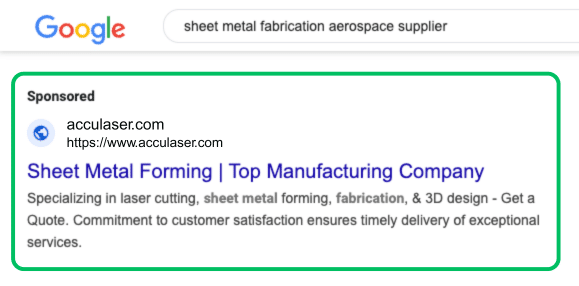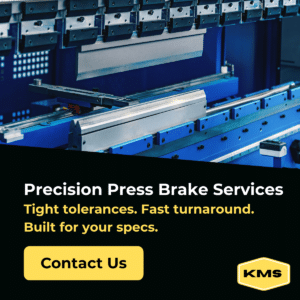When an engineer or sourcing manager needs parts fast, Google is often the first stop. If your manufacturing business isn’t showing up in those results, your competitors are getting the clicks (and the RFQs) that could be yours.
That’s where PPC for manufacturers comes in. PPC (pay-per-click) advertising, especially through Google Ads, can be a powerful way to attract qualified leads, increase RFQs, and grow your pipeline. All without needing a full-time marketing team.

For manufacturing suppliers, Google Ads offers a direct way to reach buyers who are actively looking for your services. Whether you’re a CNC machine shop, plastic injection molder, or precision metal fabricator, PPC can put your name in front of the right decision-makers at the exact moment they’re searching.
But many manufacturing businesses either haven’t tapped into the power of Google Ads or are relying on basic, underperforming campaigns. This guide will walk you through how to build better PPC ad campaigns—even if you’re not an expert in digital marketing.
Our goal is to help you get seen by decision makers, generate qualified leads, and grow your business through smarter manufacturing PPC strategies.
Why PPC Makes Sense for Manufacturing
Think of pay-per-click advertising as a way to cut to the front of the line in Google search results. You only pay when someone clicks on your ad, and you control the search terms and budget.
For manufacturers, this is huge. Your buyers aren’t browsing Instagram looking for suppliers. They’re on Google, typing in highly specific searches like:
- “custom plastic injection molding USA”
- “sheet metal fabrication aerospace supplier”
- “ISO 13485 certified contract manufacturer”
When your ad appears at the top for those searches, you’re showing up exactly where your ideal customer is looking.

Step 1: Start With Strategy
Before you begin, start with the big picture: what’s your goal?
Are you looking to increase quote requests, break into a specific geographic market, or promote a particular product or service (or several)?
Taking time to define your goals will make everything else easier and more effective. It helps you choose the right keywords, write better ads, and build landing pages that speak directly to your target audience. When your entire campaign is based on a clear goal, you’re more likely to get the results you want, like more leads, better traffic, and long-term customers.
Step 2: Set Up Your Campaigns for Control
Google Ads works best when your campaigns are well-structured. A disorganized account burns budget and makes optimization impossible.
Here’s the Google Ads structure:
Account → Campaigns → Ad Groups → Keywords → Ads → Landing Pages
Example:
- Campaign: CNC Machining Services
- Ad Group 1: Aluminum Machining
- Keywords: “aluminum CNC parts,” “custom aluminum components”
- Ad: Focuses on tolerances, lead time, certification
- Landing Page: Only about aluminum machining
- Keywords: “aluminum CNC parts,” “custom aluminum components”
- Ad Group 1: Aluminum Machining
This level of organization gives you better control over your budget, messaging, and performance.
Avoid Smart Campaigns. If you’ve tried using Google Ads before, you may have been steered into “Smart Campaigns.” These are simplified ad setups that Google recommends for beginners. They sound great—easy setup, less hands-on work—but they often don’t deliver strong results for manufacturers and industrial suppliers.
Why? Because Smart Campaigns don’t give you much control. You can’t fully control which keywords you show up for, where your ads appear, or what happens when someone clicks.
To get better results, it’s worth learning the basics of a more hands-on setup.
Step 3: Choose the Right Campaign Types
Different types of Google Ads serve different purposes. Here’s what works best for manufacturers:
Search Ads
This is where you should spend most of your budget. These ads show up when someone types a specific keyword into Google—like “precision plastic injection molding Michigan.” If you sell that exact service, your ad could show up at the top of the results.

Remarketing Ads
Show your ads to users who visited your site but didn’t convert. This is key for long-term sales cycles typical in the manufacturing industry. Buyers in manufacturing often need time before making decisions. Remarketing keeps you top-of-mind.

Display Ads
These are image or banner ads shown across thousands of websites in Google’s network. They’re great for visual branding, but not always great for direct leads—unless you’re retargeting previous visitors.
You can stay visible across industry blogs, trade publication sites, or even LinkedIn and YouTube (through connected ad placements).

Pro tip: Use multiple campaign types together to move buyers from awareness to decision.
Step 4: Smart Keyword Research
Once your Google Ads campaigns are structured, now it’s time to fill them with high-value search terms. This is not a step to rush. This defines when your ads show and who sees them, which is arguably the most important part of your PPC strategies.
Instead of broad, consumer-style keywords, focus on:
- Capabilities-based: e.g., “5-axis CNC machining services”
- Industry-specific: e.g., “medical device injection molding”
- Certifications: e.g., “ISO 9001 metal fabrication”
- Location-based: e.g., “plastic extrusion in Texas”
Free tools like Google Keyword Planner and SEMrush can help you discover what terms are popular and which ones are worth bidding on.
Use Negative Keywords to Avoid Waste
This might be the most overlooked tip in Google PPC for manufacturers: block the wrong clicks.
For example, if you’re bidding on “sheet metal fabrication,” you don’t want your ad showing up for “sheet metal fabrication careers.” That click won’t become a customer. It just wastes your money.
Add terms like “DIY,” “how to,” or “careers” as negative keywords to tell Google not to show your ad when those words are used.
Step 5: Write Ad Messages That Sell
Your ad copy needs to speak the language of your buyers—not the general public.
Example Ad Copy:
- Headline: “USA-Based CNC Machining – Fast Lead Times”
- Description: “Precision aluminum parts. ISO 9001 certified. 5-axis machining. Request a quote today.”
Include key differentiators:
- Turnaround time
- Certifications (ISO, AS9100, ITAR)
- Location and capabilities
- Free quote or fast response time
When setting up your search ads, you’ll also use something called Responsive Search Ads (RSAs). These let you enter multiple headlines and descriptions, and then Google automatically tests different combinations to see which ones perform best. It’s a great way to improve your ad results over time without having to guess which version will work best. Just make sure all your headlines and descriptions are clear, relevant, and focused on what your buyers care about.
Pro tip: Don’t forget to add sitelinks (extra clickable links) for case studies, spec sheets, or contact pages.
Step 6: Landing Pages Built to Convert
When someone clicks your ad, don’t send them to your homepage. Instead, create a dedicated landing page that matches the ad exactly.
Must-have elements:
- Matching ad message
- Technical specs and material details
- Certifications and industry badges
- Downloadable case studies or past work examples
- Clear, short RFQ form
For example, if your ad is about “aluminum CNC machining,” the landing page should show photos, specs, and tolerances related to aluminum—not general machining.
Step 7: Track Everything and Optimize
Once your campaigns are live, tracking and optimization become the most important steps. This is where you figure out what’s working—and what needs to change. Even a well-planned campaign can underperform without regular check-ins and adjustments.
Track:
- Conversions (form fills, phone calls, quote requests)
- Keyword performance
- Bounce rates on landing pages
- Cost per conversion
Measure:
- Which keywords bring in quotes?
- What landing pages convert best?
- Which PPC strategies give the best ROI?
Optimize:
- Pause underperformers
- Adjust bidding strategies
- Test new ad messages
- Expand on what’s working
Smarter PPC Advertising for Manufacturers Starts Here
With the right setup, Google Ads can become one of your most powerful growth tools. It connects you with decision makers in real time, generates qualified leads, and gives you full control over budget, targeting, and performance.
Smart, well-structured Google Ads for manufacturers can turn a few hundred dollars in ad spend into major RFQs, steady project pipelines, and long-term clients. When you combine the right digital marketing strategy with specific targeting, great content, and ongoing optimization, PPC can become a sales engine.
And the best part? You’re only paying when your ad works—when a real person clicks, visits, and engages.
Need help building or optimizing your PPC campaigns? Explore our Manufacturing PPC services and see how we can help you generate better leads, faster.



